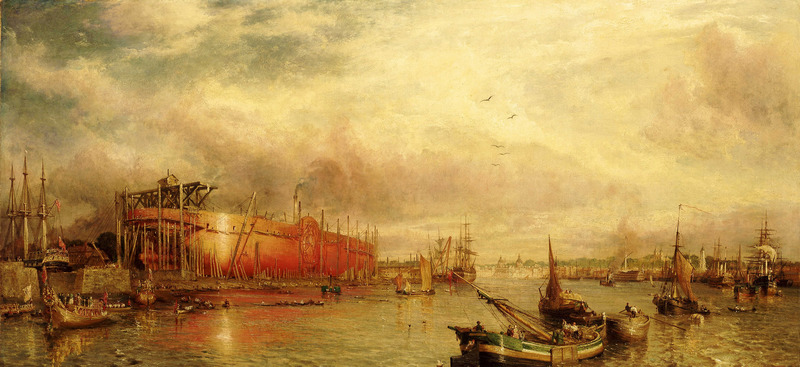Image: Building the 'Great Leviathan' (the 'Great Eastern') RMG BHC3384f

Description: Building the 'Great Leviathan' (the 'Great Eastern') A depiction of the 'Great Eastern' under construction, sitting on the stocks at Millwall on the Isle of Dogs, on the north bank of the Thames. The partially completed ship is on the left of the picture, parallel to the river into which she was launched sideways, an innovation for a major vessel. She was designed by Isambard Kingdom Brunel and built during 1857 by the engineer and iron-ship designer John Scott Russell at a site adjacent to his Millwall Shipyard. The construction of the ship demonstrated the industrial potential that would soon revolutionize transport. Built for a passenger mail service linking Britain, India, China and Australia, she was intended to accommodate 4500 passengers and 6000 tons of cargo, or to convey up to 10,000 troops to a theatre of war. She was also designed to carry 12,000 tons of coal. The 'Illustrated London News' described her as 'a grand tribute to commerce' and she was built in sections and encased in metal plates an inch thick. 'Great Eastern' was intended to be the greatest ship afloat and to demonstrate the power and superiority of the British nation, and was described during her construction as being 'mistaken for a fortress'. She was 680 feet long, 83 feet in the beam and was five times the size of the largest ship then in existence. On 3 November 1857, Miss Hope, the daughter of the director of the Great Eastern Steam Navigation Company, had named her 'Leviathan' - much to everyone's surprise since she was commonly known as the 'Great Eastern'. However, in July 1858, before her fitting-out was complete, it was announced that her name was to be changed back to that. Her launch did not take place on 3 November 1857, as intended, since her great size and weight made the task of pushing her sideways into the Thames more difficult than foreseen and she finally took to the water on 31 January 1858, aided by spring tides, before being taken down to new moorings at Deptford for fitting-out. The ship was beset with difficulties before and after her launch. The time taken to construct her ruined her builders financially and she proved a liability to her owners. After overcoming mechanical problems she departed on her maiden voyage with only 38 passengers and a crew of over 400. This painting probably forms a continuous narrative by incorporating events that took place at different times during her construction. The ship is depicted on the stocks, which means it was probably painted before the launch in January 1858. Contemporary accounts for 1857 describe her as a 'mass of bronze-and-black and brick-tinted metal' and it is this quality that the artist has attempted to capture. However, on the far left there are two barges flying the Royal Standard and another Admiralty barge. This probably denotes a private visit that Queen Victoria made to the ship at Deptford, not Millwall, on Monday, 28 June 1858. 'The Illustrated London News' for 3 July 1858 reported that the Queen spent a considerable time inspecting the ship's 'extraordinary proportions', and 'expressed her great delight at the visit'. This incorporation of the royal visit is almost certainly a later addition since the painting was shown in the annual British Institution exhibition in March 1858, before it took place. In the distance the domes and façades of Greenwich Hospital (now the Old Royal Naval College) are visible with Greenwich Park beyond. The merchant seamen's hospital ship, 'Dreadnought', with a single mast, can also be seen moored off Greenwich, to the right of the Hospital. The foreground is full of a variety of carefully observed river craft including a Dutch trading smack and Thames barges. In the foreground a Thames barge, with its mast lowered, has a number of people on board including several children. Two of the children are positioned on a small platform in the stern, trailing a rope with a small toy yacht attached. The detailing of the Thames waterfront reveals Parrott's skill as an accomplished topographical painter. This is a rare oil painting showing the ship in the course of construction and is an important socio-historic document. Robert Howlett's famous photograph of Brunel, one among a number taken at the time of the first launch attempt, shows him on the slipway in front of her. The original albumen print is now in the Victoria and Albert Museum, London, although the NMM has copies of it and others. At extreme low water the remains of the ship's wooden launching ways can still be seen at Millwall. Building the 'Great Leviathan'
Title: Building the 'Great Leviathan' (the 'Great Eastern') title QS:P1476,en:"Building the 'Great Leviathan' (the 'Great Eastern') " label QS:Len,"Building the 'Great Leviathan' (the 'Great Eastern') "
Credit: http://collections.rmg.co.uk/collections/objects/14857
Author: William Samuel Parrott
Permission: The original artefact or artwork has been assessed as public domain by age, and faithful reproductions of the two dimensional work are also public domain. No permission is required for reuse for any purpose. The text of this image record has been derived from the Royal Museums Greenwich catalogue and image metadata. Individual data and facts such as date, author and title are not copyrightable, but reuse of longer descriptive text from the catalogue may not be considered fair use. Reuse of the text must be attributed to the "National Maritime Museum, Greenwich, London" and a Creative Commons CC-BY-NC-SA-3.0 license may apply if not rewritten. Refer to Royal Museums Greenwich copyright.
Usage Terms: Public domain
License: Public domain
Attribution Required?: No
Image usage
The following page links to this image:

